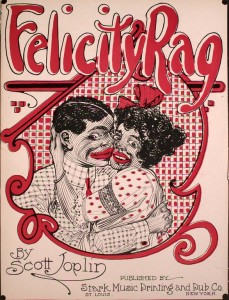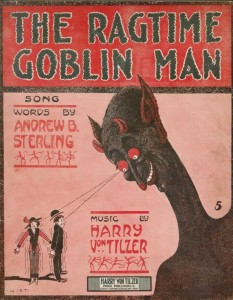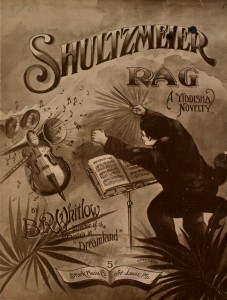Have you ever noticed that many ragtime tunes sound the same? Listen to the following two clips for their similar harmonic motion/progressions, the similarity in rhythmic syncopation/complexity, and form. Each have a general intro and short repeated sections, which unless you have become very familiar with the tune are very hard to remember.
The Felicity Rag:

The Ragtime Goblin Man:

How is it possible that publishing companies could sell something so similar sounding and make it popular? It is clear that the Felicity Rag’s cover draws on minstrel like, simian caricatures, while the Ragtime Goblin Man has an enticing cover with a devil-like character controlling two musicians who according to the lyrics will get caught by the goblin and be made to join his ragtime band. Even thought the tunes’ striking similarity make them seem unmarketable, they have been made unique and sensationalized by their evocative front cover art and titles/lyrics. Publishers, composers, and artists who could appeal to the popularity of minstrelsy, the exotic, or the romantic, had successful marketing strategies for popular music. On one hand, it is problematic to have popular tunes, that “represent” different meanings, sound the same because there is a whole lot more complexity to music across cultural/racial/imaginative boundaries. On the other hand, it would be inappropriate to put a minor mode or augmented second in the ragtime tune that is named for Jewish culture or another Other as was done in Schultzmeier Rag, a Yiddish novelty.
Now, thinking about today’s popular music, with similar harmonic progressions, rhythmic variations, and subjects, the marketing strategies really haven’t changed that much. When you think about the image sold with the music, whether it is the caricatured lifestyle of a celebrity, or the sensational lyrics, today’s popular music continues these successful marketing strategies at the expense of perpetuating problematic stereotypes.
